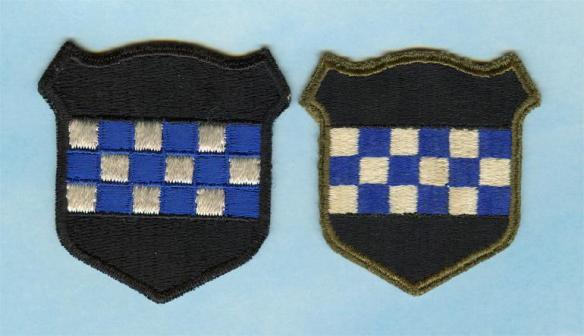99th Infantry Division shoulder sleeve insignia
Map depicting the northern shoulder of the Battle of the Bulge, or Ardennes Offensive, in which the German Sixth Panzer Army attacked the United States’ 99th Infantry Division, but could not dislodge them. The 99th Division’s effective defense of the sector prevented the Germans from accessing the valuable road network and considerably slowed their timetable, allowing the Allies to bring up additional reinforcements.
After a short artillery barrage, the Germans attacked on December 16 along an 85-mile front, taking Allied Supreme Headquarters by surprise. But what should have been easy became terribly difficult, thanks to the undaunted if greatly outnumbered Americans. Most remarkable was the defense put up by the 99th Infantry Division, a new outfit that had seen little action. Like other divisions in the Ardennes, it occupied a stretch of line that ought to have been held by a corps, the next larger unit, which equaled two or even more divisions. Although caught off guard, the men of the 99th fought back furiously, to the point of calling friendly artillery fire down on their own positions.
The 99th was the northernmost division to be attacked. Behind it lay Elsenborn Ridge, high ground covering two critical road junctions without which the Sixth SS Panzer Army could not advance. Though Dietrich did not know it, quite by chance the veteran U.S. 2nd Infantry Division was attacking just above him. As the 99th’s situation worsened, Major General Leonard T. Gerow of the V Corps, which was responsible for the northern Ardennes, put the 2nd Division’s reserve regiment in front of Elsenborn Ridge.
On December 17, Lieutenant General Courtney H. Hodges of the First Army gave Gerow a free hand. Gerow immediately ordered the 2nd Division to break off its attack and join its 23rd Infantry Regiment at Elsenborn. Hodges ordered up the famed 1st Infantry Division, “the Big Red One,” from Aachen, where it too was recuperating. The 2nd disengaged itself from the enemy in an extremely difficult operation that it executed smoothly, evidence of how good the Army had become since coming ashore in France.
Meanwhile, the 99th’s battered parts disengaged and passed through the 23rd Infantry to regroup and dig in on Elsenborn Ridge, where the 2nd and 9th divisions would join them. By December 18 Elsenborn was proving its worth. U.S. artillery laid down murderous barrages from the ridge. Protected by fog and darkness, U.S. tanks and guns were lying in wait along narrow roads, striking panzers from the side and rear, where even the Tigers were vulnerable. On the 18th, brute force having failed, Dietrich attempted to bypass Elsenborn, but his attacking force was prevented from reaching the strategic Malmedy Road by elements of the Big Red One, which had arrived just in time.
Together these four divisions, the 2nd and 99th in the center and the 9th and 1st on their flanks, created an unbreakable line by December 20. As a result of their determined stand the German counteroffensive was spoiled after only five days of battle. Dietrich realized this and wanted to settle for limited gains, but Hitler insisted on continuing the attack even though Elsenborn Ridge barred the Sixth Panzer Army from Antwerp. This was sheer stubbornness on his part, as the operation now lacked any strategic purpose.
Most accounts of the fighting turn on the 101st Airborne and its defense of Bastogne, which was indeed remarkable. But the key position in the Battle of the Bulge was Elsenborn Ridge. The holding of it by the 2nd and 99th Infantry divisions, the latter often fighting in small units out of touch with higher command against attackers who outnumbered them five or more to one, was the outstanding achievement of the battle. In the critical early days, these two divisions repelled an entire German corps, the elite First SS Panzers.
Order of Battle (1944–1945)
99th Infantry Division Order of Battle 1944-1945:
Headquarters & Headquarters Company 99th Infantry Division
Headquarters & Headquarters Battery Division Artillery
Headquarters, Special troops
Military Police Platoon
99th Quartermaster Company
99th Signal Corps Company
99th Counter Intelligence Corps Detachment
324th Engineer Combat Battalion
324th Medical Company
370th Field Artillery Battalion (105 MM)
371st Field Artillery Battalion (105 MM)
372nd Field Artillery Battalion (155 MM)
393rd Infantry Regiment
394th Infantry Regiment
395th Infantry Regiment
799th Ordnance Light Maintenance Company
924th Field Artillery Battalion (105 MM)
535th AAA A-Weapons Battalion: 11-12-1944 – 09-05-1945
629th Tank Destroyer Battalion: 22-02-1945 – 09-05-1945
644th Tank Destroyer Battalion: 28-01-1945 – 08-02-1945
750th Tank Battalion: 28-01-1945 – 05-02-1945
786th Tank Battalion: 23-02-1945 – 09-05-1945
801st Tank Destroyer Battalion: 09-11-1944 – 03-02-1945
814th Tank Destroyer Battalion: 08-02-1945 – 13-02-1945
817th Tank Destroyer Battalion: 13-02-1945 – 22-02-1945
Commanding officers
Maj. Gen. Thompson Lawrence (November 1942 – July 1943)
Maj. Gen. Walter E. Lauer (July 1943 – 18 August 1945)
Brig. Gen. Frederick H. Black (August 1945 to inactivation)
